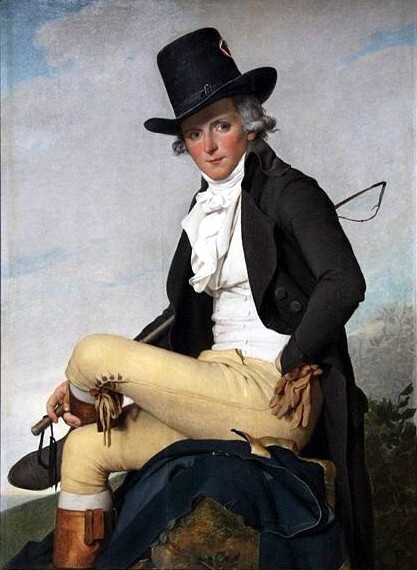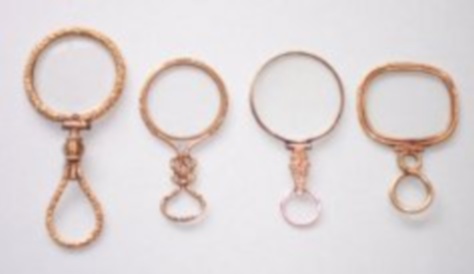Monsieur Seriziat
Painted by Jaques-Louis David, 1795.

This Frenchman wears 'morning' clothes (gentlemen went riding in the morning) in the English style.
A dark wool jacket with the skirt cut away in front, perhaps intended to be worn open as shown.
It's hard to tell from the portrait, as a jacket cut to be worn unbuttoned would have all the
buttons and button-holes in place, but be cut too small to button across. It will have been
stiffened with a horsehair and linen fabric to maintain its shape, as will the standing collar.
(This same fabric, 'crinoline', will later gain notoriety as a women's stiff petticoat).
The open jacket reveals a white or cream double-breasted vest or waistcoat in a finer material,
with a collar that is high at the back, but open in front to reveal the 'linen'.
The shirt is of fine linen, or later, Egyptian cotton lawn. (Lawn is a fine cotton which in the
lightest of weights is transparent). The shirt opens to mid chest, with full sleeves and a
simple square cut. The placket that reinforces the front opening has been embellished with
far too much material, so that it forms a softly pleated puff of white on the chest.
The collar is high, and stiffened with starch; perhaps the strained water in which potatoes
had been boiled, or a light solution of maize 'cornflour'.
The white cravat is of very fine linen, lawn, or silk. One type was as long as the man is tall
and a foot and a half wide, folded lengthways several times. The middle of the folded cravat
is placed at the centre front, wrapped not too firmly around the shirt collar to cross at the
back of the neck. Coming to the front it is tied in a bow, in any one of several fashionable
styles. (See the section 'Neckcloths')
The breeches are of fine suede leather (called 'buckskin' in America), fitted to the knee with
side buttons and a tightening lace. The drop front forms a fold across his lap. There is no
inside leg seam in the breeches; each leg is cut in one piece. (See the pattern for pantaloons
in the section 'Hill & Bucknell'.
He wears white hose (stockings) and polished black leather riding boots, with a broad tan top band.
The hair is dressed in a style that had been common for a few decades (think of Capt Cook);
soon his barber would suggest a short back and sides.
His tapered top hat has a soft edged crown and is embellished with a silk ribbon band and a
cockade probably showing his allegiance to the Republic. He carries tan leather (kid) gloves
and long riding crop.
The gloves link this gentleman with the lowest of the low. The fine leather known as 'kid'
was tanned using a material known euphemistically as 'pure'; dog turds gathered from the
kennels, or from the streets by common urchins.
Beau Brummell

As a youth Prince George had attached to his retinue another young man, George Ryan
(Beau) Brummell, for his wit and style. Brummell affected a very severe style of dress
at a time when the older men of the Royal Court were still wearing make-up, powdered wigs,
lace, and richly embroidered cloth.
Brummell is seen here wearing the refined version of the county gentleman's riding or
'morning' outfit: a closely buttoned jacket in a plain material, with the front of the
skirt cut away to reveal the new style of tightly fitting trousers. These covered the
legs to the ankle, rather than the previous style of 'breeches' that ended below the knee.
Hanging at his right hip is a 'fob'. This was most commonly a large precious stone cut with
the owner's 'seal', and used to leave an impression on the softened wax used to seal
correspondence. See the section 'Gentlemen's Fobs'. The other end of the ribbon attaching
the fob will be attached to a watch tucked into a pocket in the waistband of the trowsers.
His boots are a style known as 'Hessians' (from the German state of Hesse).
Instead of powder and scent, Brummell bathed daily and almost obsessively changed his linen
(which is to say his shirt, cravat, and undergarments) several times a day. His obsession
with his appearance, combined with what was seen then as a piercing wit on the subject,
made him for several years a reference point of Court style, and therefore also of the
style of anyone who was anyone.
Unfortunately for Brummell, his relationship with the Prince failed to mature as the Prince's
station matured. Brummell's puerile wit became more insulting, acidic and politically
incorrect and increasingly grated on the Court and the Prince, until the prince chose not
to recognise him. Brummell, unaware that the game was up, infamously asked a companion to
whom the prince had spoken, "Who is your fat friend?" Brummell was persona non grata,
and went into exile in France.
William Hazlitt wrote of him in 1828, "All his bons-mots turn upon a single circumstance,
the exaggerating of the merest trifles into matters of importance, or treating everything
else with the utmost nonchalance and indifference, as if whatever pretended to pass beyond
those limits was a bore, and disturbed the serene air of high life."
But he did dress well.

In this wax sculpture, which reflects contemporary accounts, Brummell is shown with a velvet
collar, two waistcoats (1816 was 'the Year Without a Summer', caused by a volcanic eruption
in Indonesia) and from the ribbon hangs a 'quizzer', a reading glass (obscured by his hand).
He is handling a snuffbox, but one wonders where he could pocket it in the skin-tight clothing,
and the flash ring is a dashed nuisance when wearing gloves.





